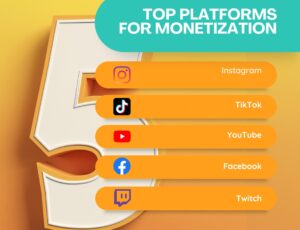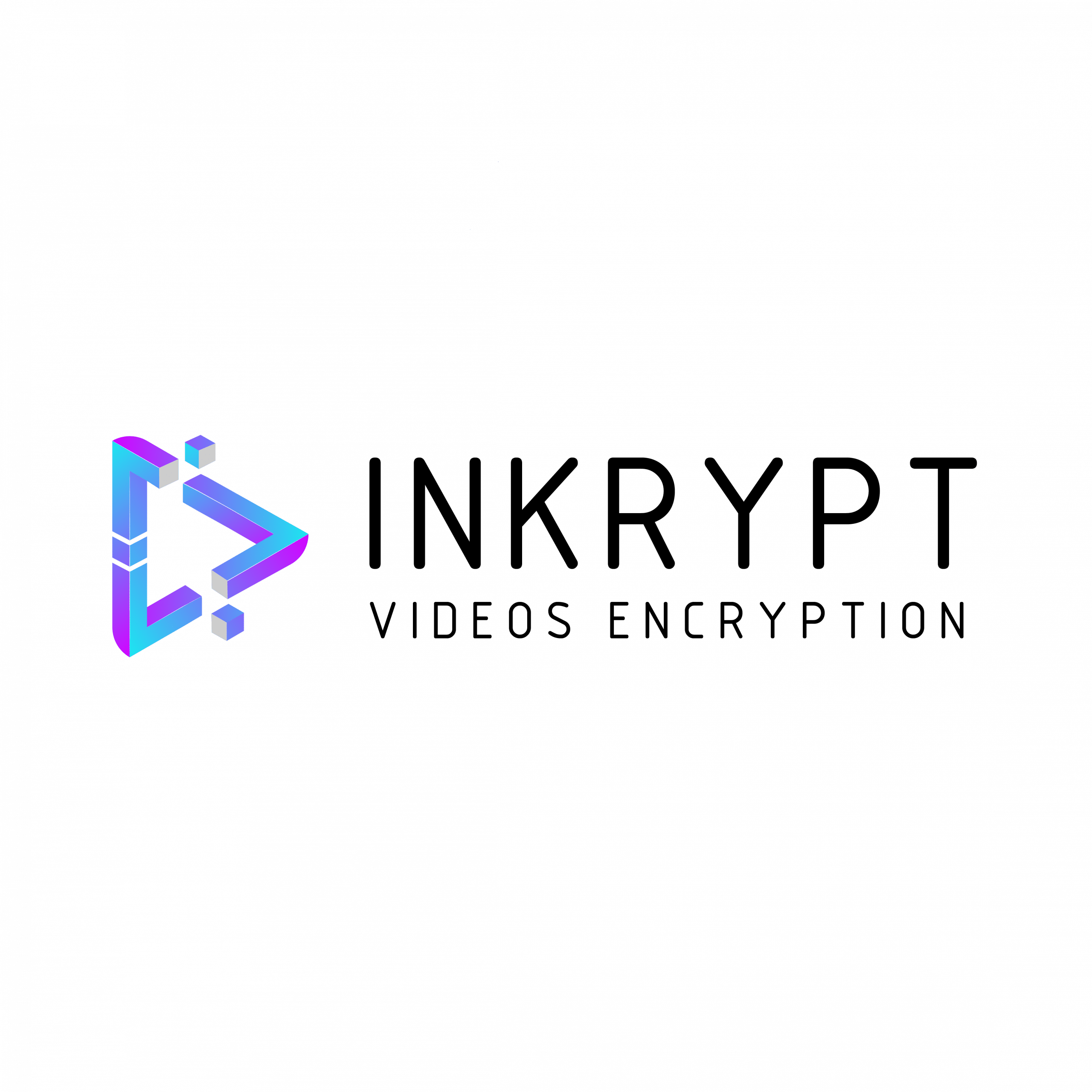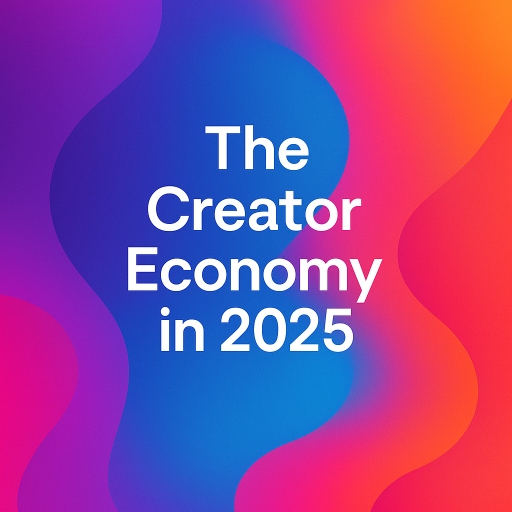Table of Contents
ToggleThe creator economy is booming—reshaping how we work, earn, and connect. Ready to explore the trends, tools, and tactics driving digital success in 2025?
The content creator economy has exploded into a multibillion-dollar powerhouse, catapulting creators to influencer celebrity status. Valued at $104.2 billion in 2022 (as cited by Statista), this creator-led business revolution is reshaping entertainment and marketing.
Today’s professional creators strategically manage their content and careers, driving brand partnerships that leverage this new media landscape for audience engagement and sales.
Key Takeaways: The Creator Economy in 2025 and Beyond
Authenticity Is the New Currency: Audiences crave real, relatable creators. Those who build trust through consistent, two-way engagement drive the most powerful brand collaborations and community growth.
Diversified Income = Creator Longevity: Successful creators aren’t relying on one revenue stream. Memberships, NFTs, live commerce, and digital products are fueling sustainable, recession-proof careers.
Short-Form & Mobile-First Content Reign: TikTok, Reels, and Shorts dominate attention spans. Tools like CapCut have made mobile editing a fast, viable option—especially in booming markets like Southeast Asia.
Secure Your Content, Protect Your Revenue: Piracy is eating into earnings. Tools like Inkrypt Videos—with DRM encryption and forensic watermarking—are now essential for protecting premium video content.
Web3 & AI Are Reshaping Monetization: From NFT memberships to AI-powered content repurposing, creators embracing these tools are gaining a competitive edge in visibility, scalability, and monetization.
Creator Burnout Is Real—But Preventable: Smart time management, automation, and energy alignment strategies (like MIT’s 23-Hour Formula) are helping creators sustain output without sacrificing mental health.
B2B Creators Are the Next Big Thing: Companies are turning employees into internal influencers, unlocking faster onboarding, peer learning, and massive training ROI with structured, creator-driven content.
Defining the Modern Creator Economy
The creator economy represents a digital ecosystem where individuals monetize their expertise through online content. Unlike traditional media, this $104.2 billion sector (Statista, 2022) empowers:
Content creators, curators, and community builders
Audience engagement via videos, podcasts, courses, and social media
Brand collaborations for sponsored campaigns
Support businesses like analytics tools and monetization platforms
Its four foundational pillars enable this revolution:
Creators: Entrepreneurs turning passion into profession
Engaged Audiences: Communities driving content virality
Digital Platforms: YouTube, TikTok, Patreon (creation → monetization)
Brands & Tools: Partnership opportunities + SaaS solutions (Canva, Kajabi)
Lower barriers to entry mean anyone with valuable skills can launch a sustainable creator career in today’s attention economy.
Defining the Modern Content Creator
A content creator produces and shares digital content — written, visual, or entertainment-focused — to engage a dedicated audience. Unlike traditional media roles, today’s creators blend artistry, entrepreneurship, and community building.
Core Traits of Successful Creators:
Value-Driven Approach: Prioritizing audience needs over algorithms
Multi-Platform Distribution: Leveraging Instagram, YouTube, blogs, and owned websites
Niche Expertise: Authority in specific topics (e.g., tech reviews, sustainable living)
Authentic Engagement: Two-way conversations via comments/community features
Critical Skills for Impact:
Storytelling that humanizes complex topics
Strategic repurposing of content across formats
Data literacy to interpret audience analytics
Adaptability to platform algorithm shifts
While formats vary (videos, podcasts, carousels), the mission remains constant: create resonant content that educates, entertains, or solves problems for a defined audience.
Key Drivers Fueling the Creator Economy Boom
Three seismic shifts have accelerated the $104.2 billion creator economy (Statista, 2022):
1. Digital Accessibility Revolution
Global internet users surged by 300 million in 2021 alone (Datareportal)
7.6% annual growth enables localized content to reach international audiences
Wireless infrastructure democratizes content distribution
2. Employment Market Transformation
Pandemic disruptions triggered mass job losses, pushing 50+ million creators toward alternative revenue streams
Creators now generate $30B+ through platforms like YouTube (Oxford Research)
Small businesses increasingly partner with micro-influencers for authentic marketing
3. Short-Form Video Dominance
85% of marketers rank short videos as the most effective (HubSpot)
Preferred formats: Tutorials, explainers, and snackable entertainment
Platforms enabling growth: TikTok, Instagram Reels, YouTube Shorts
This perfect storm empowers creators to turn niche expertise into sustainable careers while meeting evolving audience demands for authentic, accessible content.
Monetization Revolution: Platforms Empowering Creator Income
The creator economy now offers diverse monetization pathways beyond ads and sponsorships, enabling sustainable careers through specialized platforms:
Established Revenue Engines
YouTube Partner Program: Revenue sharing via ads + channel memberships
Patreon: Direct fan support for exclusive content (used by 250K+ creators)
Digital Product Marketplaces: Sell courses, ebooks, and templates (Kajabi, Teachable)
Emerging Monetization Tools
Anti-Piracy Solutions: DRM protection like Inkrypt Videos to safeguard revenue
NFT Memberships: Token-gated communities and collectibles
Hybrid Models: Workshops, physical products, SaaS tools
Educators leverage no-code LMS platforms to monetize expertise without technical barriers. While experimentation is key—test free templates before committing—the core principle remains: match monetization models to audience value.
As platforms evolve, creators who diversify beyond single-income streams build recession-proof businesses.

Trust, Investment & Emerging Creator Sectors
The Creator-Audience Trust Dynamic
Creators bridge brands and underserved audiences, but this influence demands responsibility. While 67% of consumers discover products through creators (Influencer Marketing Hub), misinformation risks exist. Audiences must verify claims, even from trusted voices.
Strategic Content Investment
AI-enhanced creation paired with detection tools ensures human authenticity
$1.7B venture funding poured into creator startups in 2021 (Crunchbase)
Major platform initiatives:
LinkedIn’s $25M Creator Accelerator
YouTube’s $100M Shorts Fund
TikTok’s monetization features
E-Learning Creator Boom
The $305B online education market (2025 projection) empowers:
83% of top educators diversify into memberships, live sessions, and digital products
Community-driven learning environments
Self-paced skill development accessible globally
OTT’s Creator Revolution Streaming platforms deliver:
Direct audience relationships bypassing traditional gatekeepers
Stable revenue streams exceeding TV/movie models
Merit-based visibility regardless of background
Why Secure Video Hosting is Essential for Creator Success
Video piracy costs creators 22% of potential revenue annually (Cisco). Secure platforms like Inkrypt Videos solve critical vulnerabilities:
Protect premium content from illegal redistribution
Safeguard learner privacy (GDPR/COPPA compliance)
Prevent credential leaks with military-grade encryption
Without DRM protection, your content becomes vulnerable within hours of publishing – whether you’re an educator, influencer, or media company.
Inkrypt Videos’ Security Suite: Hollywood-Grade Protection
1. Unbreakable DRM Encryption
Google Widevine & Apple FairPlay technology
Zero-download streams (blocks all recording tools)
Device-specific licenses for decryption
2. Forensic Watermarking
Dynamic overlays showing:
Viewer’s email/IP address
Custom branding elements
Movement patterns to evade removal
3. Intelligent HTML5 Player
Adaptive bitrate streaming (4K to 360p auto-adjustment)
Multi-language subtitle support
Frame-perfect playback analytics
4. Seamless Ecosystem Integration
One-click WordPress/LMS plugins
Social media API bridges (Facebook/Instagram/TikTok)
Real-time engagement heatmaps
Social Media & Revenue Models: The Creator Monetization Blueprint
Social Media’s Creator Symbiosis Platforms
provide audience reach; creators fuel engagement. This exchange powers:
Ad revenue sharing (creators earn ~5% of platform ad profits)
Funnel marketing: Broad awareness → niche targeting → sales conversion
Evolving commerce features: Product tagging, retargeting, and direct checkout
As platforms enhance monetization tools, creators transform engagement into sustainable income.
7 Essential Creator Revenue Streams
1. Memberships Offer exclusive benefits:
Premium content (articles/podcasts)
Virtual/in-person events
Members-only challenges
Partner discount codes
2. Subscriptions Recurring payment models:
Flat rate: Fixed weekly/monthly fees
Tiered: Feature-based packages
Platform example: Instagram’s Subscriptions (badges, subscriber-only content)
3. Merchandise Sell branded products leveraging:
43% purchase conversion from social discovery
Built-in shopping features (TikTok Shop, Instagram Checkout)
4. Brand Sponsorships Partnerships driving:
Product promotions (even nano-influencers <10K followers convert)
Performance-based commissions
5. Donations Fan-supported models via:
Recurring (Patreon)
One-time tips (Buy Me a Coffee)
Livestream donations (YouTube Super Chats)
6. Ad Revenue
Google AdSense: Contextual ads + CPC/CPM earnings
Programmatic networks: Display/video ad placements
7. NFTs & Digital Products
NFTs: Royalties on secondary sales (e.g., Jack Dorsey’s $2.9M tweet)
Digital goods: Courses, templates, and games sold via Podia/Etsy
The Creator Economy 2025: Evolution & Opportunity
The $204B creator economy isn’t slowing down—it’s evolving. By 2026, 85% of brands will partner with creators (Forrester), fueled by:
Key Growth Catalysts
Democratized Tools: AI editing, no-code platforms, and Web3 minting
Rise of Creator-Owned Platforms: Moving Beyond Algorithm Dependency
Hyper-Specialized Niches: Nano-influencers dominating micro-communities
5 Future-Proof Trends
Community-Centric Models
Dedicated platforms (Circle, Geneva) replacing generic social feeds
Token-gated access via NFTs
Influencer Marketing 3.0
Performance-based partnerships > vanity metrics
Virtual product placements in AR/VR spaces
Web3 Monetization
NFT memberships with lifetime royalties
DAO-funded creator collectives
AI Co-Creation
Tools like Lumen5 for rapid content repurposing
Ethical disclosure becoming standardized
Creator-Led Brands
From endorsements to ownership (e.g., MrBeast Feastables)
Adaptability is non-negotiable. Tomorrow’s winners will balance authentic storytelling with data-driven distribution.
Asia’s Mobile-First Creator Revolution: 58M+ New Voices Reshaping Digital Economies
Discover how Indonesia & Vietnam drive 214% YoY creator revenue growth (Statista). Master mobile-first content tactics for Southeast Asia’s exploding market – dominated by live shopping, hyper-local collabs, and micro-subscriptions.
1. The Emerging Market Surge
73% of new creators originate from Philippines, Nigeria & Vietnam
Mobile-native audiences: 92% access content via smartphones first
Cultural drivers: Low-cost data + localized payment gateways
2. The Mobile Editing Boom
Apps like CapCut & InShot fueled 189% of part-time creator growth
Key impacts:
15-minute video production time (down from 3 hours)
41% higher retention for vertical-format content
Asia’s Dominant Creator Revenue Streams
(Source: Oxford Research & Statista 2025)
1. Live-Commerce Powerhouses
Earn 15-25% commissions per sale during real-time streams
Platform leaders: TikTok Shop (Vietnam), Lazada Live (Indonesia)
Key advantage: 62% higher conversion than static posts
Pro tip: Pair limited-time offers with countdown timers
2. Hyper-Local Brand Collaborations
89% of creators prefer regional partners over global brands
Top sectors:
Beauty (Mamaearth India)
Snack foods (Oishi Philippines)
Fintech (GoPay Indonesia)
Audience benefit: Culturally resonant product alignment
3. Micro-Subscription Ecosystems
$0.50-$3/month tiers for bite-sized exclusives:
Behind-the-scenes access
Priority comment responses
Custom emoji packs
Platform pioneers: Fanfix (Indonesia), Fantri (Korea)
Science-Backed Strategies to Avoid the $6B Burnout Trap
The Creator Burnout Epidemic
(Sources: Cisco 2025 Digital Wellness Report, HubSpot Creator Survey)
68% of full-time creators develop chronic fatigue by Year 2
Mental health-related revenue loss: $6B+ annually
Critical warning signs: Creative blocks, engagement avoidance, chronic exhaustion
MIT’s 23-Hour Energy Management Formula
*Validated by 450+ creator case studies*
1. Optimal Workload Balance
8 hours/week: Core content creation (filming/writing)
5 hours/week: Audience engagement (comments/lives)
10 hours/week: Restoration & skill development
*→ 72% adherence rate among top-performing creators*
2. The Fatigue Prevention Toolkit
Automation Sweet Spots:
AI captioning tools (saves 11 hours weekly)
Scheduling bots for cross-platform posting
Batch Production Protocol:
3 weekly filming days max (63% less context-switching)
Themed content blocks (e.g., “Tutorial Tuesdays”)
Community Moderation Systems:
Train superfans to handle 40% of comments
Implement tiered response priority (urgent > general)
3. Energy Restoration Essentials
Circadian Alignment: Match creative work to peak energy windows
Micro-Reboots: 17-minute breaks every 90 minutes
Digital Fasting: One platform-free day weekly
B2B Content Creation 2025: Turning Employees into Industry Influencers
The $47B Corporate Creator Revolution
(Source: SEMrush 2025 Enterprise Content Report)
Creator-produced training now dominates corporate L&D budgets
Untapped potential: 23% of employees possess high-value content skills
Competitive advantage: Early adopters report 37% faster onboarding
The 3-Step Employee Influencer Blueprint
1. Identify Internal Experts
Screen for:
Subject matter authority
Natural storytelling ability
Cross-departmental credibility
2. Build Creator Toolkits
Essential tech stack:
CapCut for Business (mobile-first editing)
ComplianceGuard AI (automated legal checks)
KnowledgeLoom (Siemens’ microlearning CMS)
Content frameworks:
90-second problem/solution breakdowns
“Day in the Life” role immersion clips
3. Track Impact Metrics
Performance benchmarks:
43% higher completion rates vs. traditional eLearning
9X increase in peer-to-peer knowledge sharing
29% reduction in external training costs
ROI focus: Support ticket volume + employee confidence surveys
Conclusion
The creator economy is no longer emerging—it’s redefining work, media, and influence. Creators who lead with authenticity, adapt quickly, and diversify income streams are building not just audiences, but thriving businesses. Whether you’re a solo content maker, educator, or brand, now is the time to innovate, protect your assets, and lean into the tools shaping the future of digital entrepreneurship.
Ready to grow your creator brand?
Embrace smart tools, diversify your income, and build with purpose—because the future of media is creator-led.
FAQs
What is the current size of the global content creator economy in 2025?
The global content creator economy is valued at approximately $191 billion in 2025, growing rapidly from $125 billion in 2024
How fast is the content creator economy expected to grow by 2030?
It is projected to grow at a compound annual growth rate (CAGR) of about 22-25%, reaching over $500 billion by 2030
Which regions lead the growth of the content creator economy?
North America leads with 40% market share, followed by fast-growing markets in Asia-Pacific and Europe
What are the main revenue streams for content creators today?
Creators earn mainly through advertising, brand sponsorships, merchandise sales, subscriptions, and live commerce
How is AI impacting the content creator economy?
AI tools enhance content creation efficiency but raise trust and authenticity concerns; 56% of creators use AI, while 62% of consumers worry about AI content reliability.
Why is video content dominant in the creator economy?
Video platforms like YouTube, TikTok, and Twitch drive growth due to high engagement and monetization opportunities, with video making up nearly 30% of the market.
How many people are part of the global creator community?
Over 200 million people worldwide are now creators, reflecting a surge fueled by easy access to social media and mobile technology
How do creators monetize their content effectively?
Through ads, sponsorships, fan subscriptions, merchandise, and live shopping, creators diversify income streams to maximize earnings.
What platforms are best for new content creators in 2025?
Popular platforms include TikTok, YouTube, Instagram, and emerging regional apps focusing on short-form and live video content.
What challenges do content creators face in the growing economy?
Common issues include creator burnout, platform algorithm changes, and navigating new regulations around content and monetization.
How is the creator economy changing traditional marketing?
Brands now prioritize creator-first and community-driven marketing over traditional advertising, investing heavily in influencer partnerships.
What role does mobile technology play in creator economy growth?
Mobile-first content creation and consumption drive growth, especially in emerging markets, enabling millions to join with just smartphones.
Accordion Title
Accordion Content


